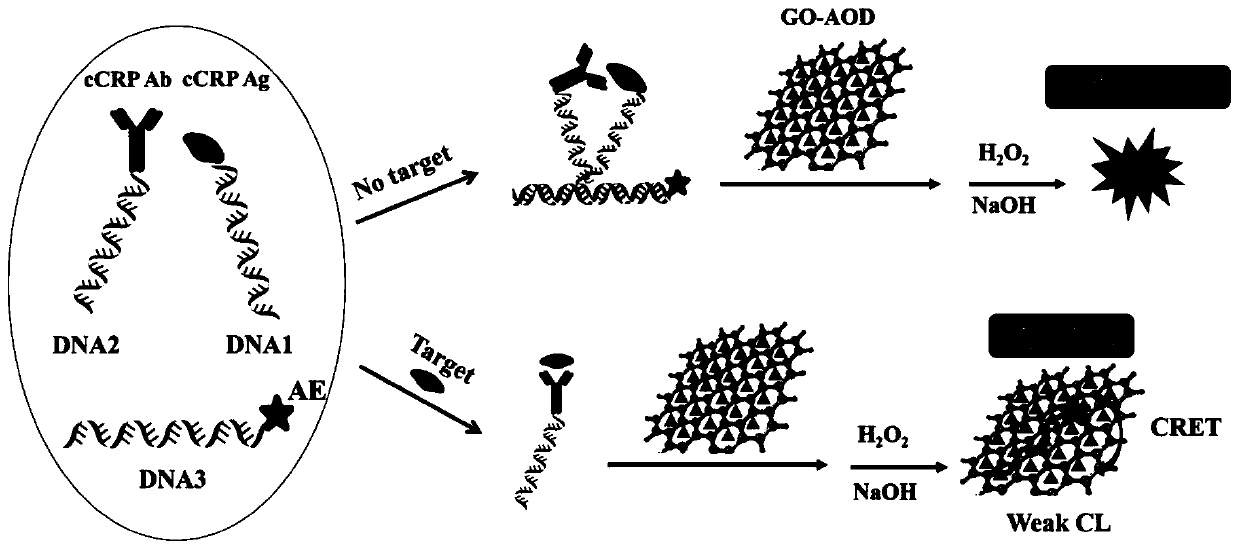Kit for detecting canine C-reactive protein based on homogeneous chemiluminescence immune competition method
A homogeneous chemiluminescence and reactive protein technology is applied in the field of kits for detecting canine C-reactive protein based on homogeneous chemiluminescence immunocompetitive method, which can solve problems such as inconvenience and achieve accurate results, short time consumption, and shortened turnaround time. Effect
- Summary
- Abstract
- Description
- Claims
- Application Information
AI Technical Summary
Problems solved by technology
Method used
Image
Examples
Embodiment 1
[0040] Configure detection reagents: mix DNA1-cCRP antigen conjugate (cCRP Ag), DNA2-cCRP antibody conjugate (cCRPAb), AE-modified DNA3, and GO-AOD to make their final concentrations respectively 1nM, 5nM, and 0.05 μM and 20 μg / ml. Mix 20 μL of calibration solution with different concentrations (0, 5, 15, 30, 60, 100, 200 mg / L) with 200 μL of detection solution, place in HSCL-10000 chemiluminescence instrument, and incubate at 37°C for 5 minutes . After incubation, 200 μL of chemiluminescence substrate was added by HSCL-10000 chemiluminescence instrument, and the chemiluminescence signal of the solution was detected by photomultiplier tube (PMT) immediately, and the detection time was 3 s. According to the recorded chemiluminescence value (RLU), the calibration curve of cCRP and the concentration of cCRP in the sample to be tested are obtained. The specific results are shown in Table 1.
Embodiment 2
[0042] Configure detection reagents: mix DNA1-cCRP antigen conjugate (cCRP Ag), DNA2-cCRP antibody conjugate (cCRPAb), AE-modified DNA3, GO-AOD to make their final concentrations respectively 5nM, 10nM, 0.1 μM and 20 μg / ml. Mix 20 μL of calibration solution with different concentrations (0, 5, 15, 30, 60, 100, 200 mg / L) with 200 μL of detection solution, place in HSCL-10000 chemiluminescence instrument, and incubate at 37°C for 5 minutes . After incubation, 200 μL of chemiluminescence substrate was added by HSCL-10000 chemiluminescence instrument, and the chemiluminescence signal of the solution was detected by photomultiplier tube (PMT) immediately, and the detection time was 3 s. According to the recorded chemiluminescence value (RLU), the calibration curve of cCRP and the concentration of cCRP in the sample to be tested are obtained. The specific results are shown in Table 1.
Embodiment 3
[0044] Configure detection reagents: mix DNA1-cCRP antigen conjugate (cCRP Ag), DNA2-cCRP antibody conjugate (cCRPAb), AE-modified DNA3, and GO-AOD to make their final concentrations respectively 1nM, 10nM, 0.1 μM and 20 μg / ml. Mix 20 μL of calibration solution with different concentrations (0, 5, 15, 30, 60, 100, 200 mg / L) with 200 μL of detection solution, place in HSCL-10000 chemiluminescence instrument, and incubate at 37°C for 5 minutes . After incubation, 200 μL of chemiluminescence substrate was added by HSCL-10000 chemiluminescence instrument, and the chemiluminescence signal of the solution was detected by photomultiplier tube (PMT) immediately, and the detection time was 3 s. According to the recorded chemiluminescence value (RLU), the calibration curve of cCRP and the concentration of cCRP in the sample to be tested are obtained. The specific results are shown in Table 1.
PUM
 Login to View More
Login to View More Abstract
Description
Claims
Application Information
 Login to View More
Login to View More - R&D
- Intellectual Property
- Life Sciences
- Materials
- Tech Scout
- Unparalleled Data Quality
- Higher Quality Content
- 60% Fewer Hallucinations
Browse by: Latest US Patents, China's latest patents, Technical Efficacy Thesaurus, Application Domain, Technology Topic, Popular Technical Reports.
© 2025 PatSnap. All rights reserved.Legal|Privacy policy|Modern Slavery Act Transparency Statement|Sitemap|About US| Contact US: help@patsnap.com



